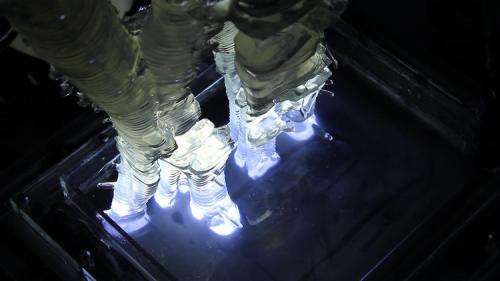October 22, 2012 report
Interruptible 3-D printing method wins Gehry prize (w/ Video)

(Phys.org)—A husband and wife architecture team have managed to turn 3-D printing into something that is less rigidly planned and more on the fly and have won a prestigious award as a result. Liz and Kyle von Hasseln are winners of the inaugural Gehry Prize from the Southern California Institute of Architecture (Sci-Arc) in Los Angeles. The prize is named after architect Frank Gehry, who is known around the world for his architectural wonders including the Guggenheim in Bilbao, Spain; the Walt Disney Concert Hall in downtown Los Angeles; and the Dancing House in Prague.
The prize is given to those who can demonstrate exceptional thesis projects. The couple won for their method of 3-D printing that allows the user to make changes to the design in progress.
In 3-D printing an object is created by laying down successive layers of material that can render finished objects.3-D Printers make objects in three dimensions, layer by layer, which may be only microns thick. The model that is destined for replication has usually been fully resolved. The Phantom Geometry method allows the user, in contrast, to print outside the specifications of a given 3-D mode. Fundamentally the Phantom Geometry method is designed to create a physical model of streaming information. Using advanced robotic arms, the von Hasseln team proceeded to manipulate the model as it was being printed. According to their idea, as a printed product emerges, the designer can make alternations to the design in-progress, and in so doing change the downstream architecture of the printed product.
Their system has a UV light projector, a special photo-sensitive resin, and controlled robotic arms from SCI-Arc's Robot House. One robotic arm supports a projector at a stable height, while a second holds a vat of resin. The second arm moves the vat into the projector's light beam of light. The designer tells the computer where and when to expose that vat to the projector's rays. The designer is free to interrupt the process and change the model while it is being printed. As a result, one can work with a fabrication system that relies on real-time feed-back and feed-forward mechanisms, they said, and is therefore "interruptible and corruptible at any time."
As they explain in their own words, "The system uses UV light from a modified DLP projector to continuously and selectively cure photo initiated resin within a shallow vat system we developed for the project. The cured part is simultaneously and continually pulled away from the vat, allowing un-cured resin to flood in beneath it to be subsequently cured. The result is the material reification of streaming data that emerges along the motion path of the Staubli robot maneuvering the vat/projector apparatus."
SCI-Arc is an independent architecture school. The school's Robot House is a cross between studio and shop, academy and industry, utilized as a research space for experimentation. Students have access to a multi-robot platform that includes six Stäubli robots, each with a full sphere of motion, operating in one flexible configuration, or in what the school calls a multi-robot work cell.
© 2012 Phys.org



















